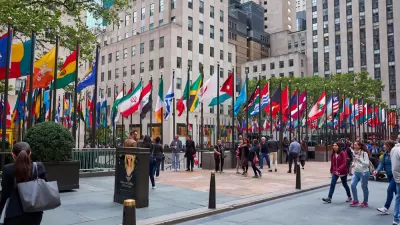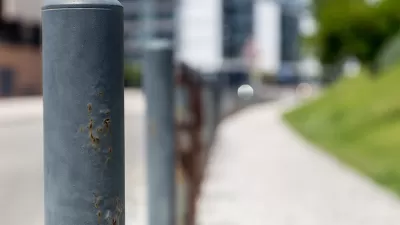Strategies for securing public spaces from vehicle attacks and other acts of terrorism without sacrificing accessible, vibrant urban places.

How can cities better protect people in public spaces from vehicle attacks and other threats? Writing in Bloomberg CityLab, John Surico attempts to unpack this question in the wake of the deadly attack in New Orleans, in which a truck was used to kill over a dozen people as protective bollards were being replaced.
According to Rob Reiter, a security consultant who specializes in vehicle attacks, says cities should more carefully evaluate potential “collision points” where pedestrian-heavy corridors intersect with roadways open to vehicle traffic. Reiter points to New York City’s low-tech intervention for New Year’s Eve: “dozens of garbage and dump trucks laden with sand, parked bumper-to-bumper to block any intrusions,” providing a practically impenetrable perimeter.
Outside of special events, cities can use “sculptural barriers,” trees, and other decorative — but solid — items to create a “positive perimeter” that offers protection without creating a hostile environment.
Surico concludes that “The long-term benefits of security improvements can’t necessarily be counted in just lives saved. Just as a community that’s more hospitable to older adults or children is more hospitable to everyone else, too, making spaces better protected from vehicle attacks can also just make them better, period.”
FULL STORY: What Can Cities Do to Protect Public Spaces From Vehicle Attacks?

Alabama: Trump Terminates Settlements for Black Communities Harmed By Raw Sewage
Trump deemed the landmark civil rights agreement “illegal DEI and environmental justice policy.”

Study: Maui’s Plan to Convert Vacation Rentals to Long-Term Housing Could Cause Nearly $1 Billion Economic Loss
The plan would reduce visitor accommodation by 25% resulting in 1,900 jobs lost.

Planetizen Federal Action Tracker
A weekly monitor of how Trump’s orders and actions are impacting planners and planning in America.

Wind Energy on the Rise Despite Federal Policy Reversal
The Trump administration is revoking federal support for renewable energy, but demand for new projects continues unabated.

Passengers Flock to Caltrain After Electrification
The new electric trains are running faster and more reliably, leading to strong ridership growth on the Bay Area rail system.

Texas Churches Rally Behind ‘Yes in God’s Back Yard’ Legislation
Religious leaders want the state to reduce zoning regulations to streamline leasing church-owned land to housing developers.
Urban Design for Planners 1: Software Tools
This six-course series explores essential urban design concepts using open source software and equips planners with the tools they need to participate fully in the urban design process.
Planning for Universal Design
Learn the tools for implementing Universal Design in planning regulations.
Caltrans
Smith Gee Studio
Institute for Housing and Urban Development Studies (IHS)
City of Grandview
Harvard GSD Executive Education
Toledo-Lucas County Plan Commissions
Salt Lake City
NYU Wagner Graduate School of Public Service




























